Museums and Cultural Centers | Sights and Attractions
Arequipa is the capital and largest city of the Arequipa Region and the seat of the Constitutional Court of Peru. It is the third most populous metropolitan area of Peru and according to the National Institute of Statistics and Informatics is the second most populous city with 861,145 inhabitants.
Arequipa is the second most industrialized and commercial city of Peru. Its industrial activity includes manufactured goods and camelid wool products for export. The city has close trade ties with Chile, Bolivia and Brazil.
The city was founded on August 15, 1540 by Garcí Manuel de Carbajal as ‘Villa Hermosa de Nuestra Señora de la Asunción”. By Royal Decree of September 22, 1541, King Charles V of Spain granted Arequipa the title of ‘City’. During the Colonial period, Arequipa became highly important for its economic prosperity and for its loyalty to the Spanish Crown.
After Peru gained its independence from Spain, the city acquired greater prominence in politics, being the center of uprisings. Many Peruvian intellectual, political, and religious figures became prominent in this era. Moreover, it was declared the capital city of Peru in 1835 and 1883.
The historic center of Arequipa spans an area of 332 hectares and is a UNESCO World Heritage Site. Its historic heritage, natural scenery and cultural sites, make the city a national and international tourist destination. Its religious, colonial, and republican architectural styles blend European and native characteristics into a unique style called “Escuela Arequipeña”.
The city is located at 2,328 metres (7,638 ft) of elevation above sea level, with the lowest part of the city being at 2,041 metres (6,696 ft) above sea level in the area called Huayco Uchumayo while the highest is located at 2,810 metres (9,220 ft) above sea level.
The central part of the city is crossed by the Chili River from north to south; to the north and east of Arequipa are the Andes mountains, while to the south and west there are minor mountain ranges associated to the Andes. The valley of Arequipa, open toward the coast, plays a key role in allowing Arequipa to be a city that strategically links the coastal and highland regions of southern Peru.
A series of volcanic cones dominates the skyline from the city. These volcanoes form mountains like the Misti, Pikchu Pikchu and Chachani. This rugged Andean western edge of South America is characterized by thick layers of volcanic lava that cover large areas.
 The climate of the city is predominantly dry in winter, autumn and spring due to the low atmospheric moisture and an effective precipitation corresponding to that of a semiarid climate. Arequipa has also 300 days of sunshine a year on average. Throughout the year, temperatures do not exceed 25 °C (77 °F) and rarely drop below 10 °C (50 °F). The wet season lasts from December to March and is marked by the presence of clouds in the afternoon and low rainfall. In winter (June, July), weather gets a little cooler and the temperature drops to an average of 10 °C (50 °F).
The climate of the city is predominantly dry in winter, autumn and spring due to the low atmospheric moisture and an effective precipitation corresponding to that of a semiarid climate. Arequipa has also 300 days of sunshine a year on average. Throughout the year, temperatures do not exceed 25 °C (77 °F) and rarely drop below 10 °C (50 °F). The wet season lasts from December to March and is marked by the presence of clouds in the afternoon and low rainfall. In winter (June, July), weather gets a little cooler and the temperature drops to an average of 10 °C (50 °F).
The average relative humidity is 46%, with an average high of 70% in the summer season and a minimum average of 27% during the seasons of autumn, winter and spring, according to data from the weather station at Goyeneche Hospital.
The winds are influenced by a system of local winds and the passage of frontal systems of low atmospheric pressure, which are conditioned by the topographical surrounding the valley where the city is. These winds occur mainly in the evening and early morning; mountain breezes flow in a north-east direction and in the course of the day valley breezes dominate with a South-West direction. The wind velocity along the day fluctuates between 1.5 m / s and 2.5 m / s.
The global solar radiation recorded in the city ranges from 850–950 W / m 2 (watts / square meter), considered one of the highest levels of radiation in South America and the highest recorded in Peru. This phenomenon is due to its proximity to the area of influence of the Atacama Desert and pollution at every stage.
Historic Centre
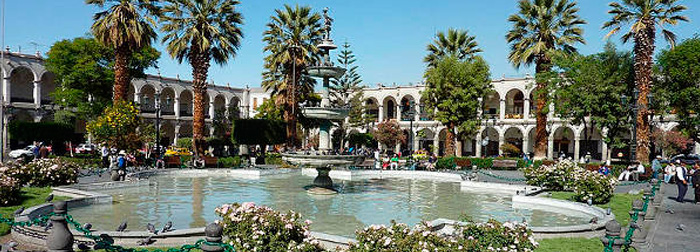
On 15 August 1540 a plot was made forty-nine “blocks or islands.” sides were measured and each had a length of “400 feet Castilians’ (111.40 meters), separated by streets” 37 feet Castilian “(10.30 meters), so that the checkerboard foundation is characterized by perfection in drawing apples.
The writer Pedro Davalos and Lisson, in his book The First Century contains the description given by Paz Soldan in 1855.
Because of this, there is no doubt that the former “Villa Hermosa de Arequipa” he intended to occupy the regional capital. The city became a connecting link between Cuzco, ponds and the ocean. And in fact the city of Arequipa in the exploitation phase of silver in Potosi, has since become “‘a major logistics hub.” The urban setting near the present district of San Lazaro, where was erected the first chapel of the city occupied an area of 850 x 875 meters.
The square foundation, located three blocks from the river and occupied an eccentric position in the founding and checkerboard patterns as Hispanic was the focal point of the city. Apples was occupied by four or eight lots, and were distributed according to their importance in the new neighborhood. With the passage of time some religious institutions came to occupy a block as the case of the Convent of Santa Catalina and San Francisco Monastery.
Republican Era
In the Republican era shows a growth process similar to the colonial era, where the urban area has grown at the expense of the countryside, a process that has worsened in recent decades. The city also experienced an expansion to the east of what is now called historic, new avenues were plotted as Parra Boulevard and Twentieth Century Avenue, was established wooded neighborhood of El Vallecito, where he built the first shawls to the 1940s, and the city extended into Yanahuara, poor people came to occupy the districts of Miraflores, Barrio Obrero, Jacinto Ibanez.
Urban architecture is extended with new construction, and moved the market town located in the Plaza de Armas to the park Duhamel and later to its present location at the Convent of the Order of St. Camillus agonizing Parents, between 1905 and 1910 Goyeneche Hospital was built, also built bridges linking the city center with the district as the bridge Yanahuara Real. By the year 1940, the first project was proposed expansion and urban facilities. This plan envisaged the creation of a ring of houses greater than existing growth plan consolidating regarding radial and concentric paths regarding land use, neighborhoods were enabled Cuarto Centenario and Selva Alegre. He was also given a boost to urban facilities with the construction of the Municipal Theatre, the Hotel de Turistas, the Municipal Library, the Athenaeum Theatre, American Independence College, Campus of the Universidad Nacional de San Agustin.
Until the late 1950s there were two factors that substantially changed the trends of urban growth, the earthquakes in the years of 1958 and 1960 and the drought plateau, which accelerated peripheral growth.
This period starts with greater force the displacement of resident population sectors, there is a shift in the industry that was located in the Barrio del Solar and El Barrio Obrero following the creation of the industrial park, causing a process outsourcing of the city center towards commercial activities primarily in the informal sector. An example of this exodus is the displacement of some educational institutions that previously were located in the city center as the National University of San Agustin in the year of 1962 and residential sectors to consolidate the periphery to the center of the city as a dynamic central business district.
In Arequipa tourism is a factor of the economy energizing establishing itself as the third most visited city in the country after Cusco and Lima. In 2010, Arequipa received a total of 1.395 million visitors according to the Ministry of Commerce and Tourism.
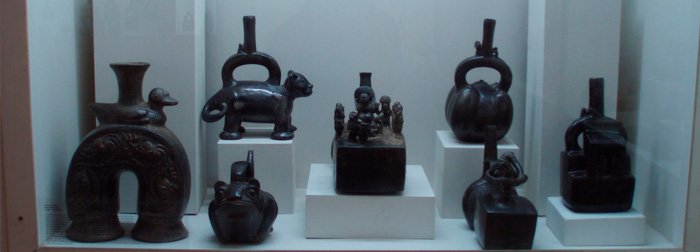
Its principle is based or iconographic art of petroglyphs and pre-Columbian pottery. The site with more graphs in stone are the Toro Muerto has been the subject of many studies, most notably those of Dr. Eloy Linares Málaga and Dr. Antonio Núñez Jiménez Cuban.
His second contribution is the Spanish state and Indo-American, who initially had applications in the size of walls, faces carved churches and altars, des painting appeared as mestizo, which is a naïve tried to recreate the Christian symbolism . The art of deep chiaroscuro, anatomical and ingenuity hieratic provisions lasted for many years since the European Renaissance failed hard because of geographical distance, but so that the increased media and travel advances and ado came to the third stage, which is the art academic and romantic, then arequipeñas wealthy families brought European art, mostly from France, England and Spain, the art, but not high-level teachers, gave the foundation for what would advance the fourth state of our history of fine arts, Carlos Baca Flor, Masias and Reynoso Vinatea preamble contemporary art Teodoro Nunez Ureta, Ureta Alejandro Nunez and Luis Palao Berastain among youth of that based on the short edge new American realism and impressionism .
After the fifth stage amorphous art, symbolist and other current and conceptual styles imported from North America and Europe with vertigo by mass media, among the master of this new era are Ramiro Pareja, Germán Rondon, Ricardo Córdova, the Evaristo and brothers Dario Callo Anco, Erick Huanca, Juan Carlos Zevallos, Companoca and other young master that currently contribute at various isms and boundaries of what is visual art. The Museum of Contemporary Art and the Museum of Arequipa Fundo del Fierro are good benchmarks.
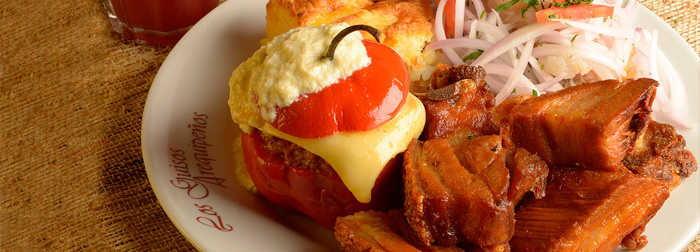
The city has a great diversity of foods compared to many other parts of Peru, with a registered 194 varieties of dishes, which represent 40 entrees, 11 soups or lunches, 11 wines, 70 dishes, 51 desserts and 11 drinks. The cuisine of the city stands by the use of seasonings and preparation methods introduced by both Andean and Europeans, because many dishes were created to satisfy the tastes of Spanish merchants, soldiers and priests who had settled in Arequipa.
The eating habits are characterized by a slow diet for each day of the week, this fact shows that in most restaurants and picanterías gets used to prepare on Monday: Chaque, Tuesday: Chairo, Wednesday: Chochoca, Thursday: Suck Colorado or potato flour, Friday: Suck, Saturday: stew or Timpusca and Sunday: white broth or Pebre loins. This practice follows a global context where food has established fixed schedules and are respected by the population and most restaurants and picanterías city and moved to the availability of specific ingredients in local markets to meet demand according to the day of the week.
Among the most popular dishes are the shrimp Suck, Ocopa Arequipa, Rocoto filling Adobo Arequipa, Single cheese, potato cake, fried ribs, Cuy chactado, Cauche cheese, Locro pectoris, Chaque, among others. For dessert highlight the cream cheese, donuts, convent sweets, chocolates, and beverages such as, Chicha de Jora, the region anise (anise or aniseed liqueur).
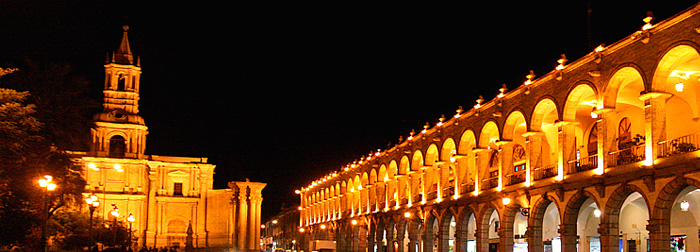
Cultural events are mainly in the cultural institutes, organizations such as the Alliance Française, the Peruvian Center for German and Peruvian North American Cultural Center organized activities around the arts, music, dance and literature, among others. Meanwhile, the Centro Cultural de la Rosa Chaves National University of San Agustin and the Catholic University of Santa Maria promote cultural activities.
In the 1990s banking institutions showed great interest in promoting and managing cultural activities, private companies, meanwhile, joined this movement by sponsoring various projects.
- Cathedral Museum
- Virtual Hall of Arequipa, located at the “Gateway to the City” are contained several aspects of urban town of the historic center of Arequipa, more precisely the area that has been declared as a World Heritage Site and some nearby; here shows the evolution of the architecture over time arequipeña.
- Regional Museum of the Central Reserve Bank. The center has a numismatic room, where you can see notes and coins that were minted in the Central Reserve Bank of Arequipa in the sixteenth and seventeenth centuries. The museum also has a gallery comprising 17 eighteenth-century paintings of the Cusco School, and archaeological pieces in metal and ceramics from the Chavin, Chimu, Moche, Viru, Recuay, Nasca and Inca.
- Archaeological Museum José María Morante.
- Archaeological Museum of the University of St. Augustine, located in a seventeenth-century mansion, the museum exhibits a varied collection comprising lithic, bone remains of human sacrifices, pottery elementary and pre-Columbian textiles.
- UCSM Archaeological Museum, displays about 1000 objects developed different cultural groups in the region from 12 000 a year. C. until the colony: Nasca, Tiahuanaco, Wari, Churajón, Acari, Aruni and Inca, and colonial and transitional material.
- Andean Sanctuaries Museum of the Catholic University of Santa Maria, was created on 26 March 1997, following the significant archaeological research by Project ‘height Sanctuaries Southern Andes “, led by Professors Johan Reinhard and Jose Antonio Chavez.[133] In this museum is the Mummy Juanita who was sacrificed on Mount Ampato, despite being an attractive displays, museum work has been questioned.
- Numismatic Museum
- Museum of Contemporary Art, is devoted to painting and photography from 1900 onwards, houses an interesting collection of twentieth-century art, photography and exhibitions of Miguel Vargas and Carlos Vargas, Cusco photographer Martin Chambi, was mentor of the two brothers, that through his work documenting daily life and customs of the city of Arequipa twentieth-century. Also on display are works by young local artists, paintings of Peruvian artists like Fernando and Carlos Enrique Polanco Szyszlo, Ramiro Llona, José Tola, Gerardo Chavez, Natalia Iguíñiz, Jaime Higa, Light Letts, Carlos Runcie Tanaka, Amelia Weiss, Claudia Cuzzi and Venancio Shinki.
- Museum of Natural History, located in the metropolitan district of Yanahuara, under the administration of the convent of La Recoleta.
- Museo de Santa Catalina
- Graphic Museum Gazette, the house museum located in Bolivar, it shows the evolution of writing from cave paintings to the first printing presses and machinery involved in the production process of official gazette El Peruano. In this museum you can see the resolution of Arequipa passport and Original Declaration in which Arequipa is declared on 4 September 1882 as “Capital of Peru”.
- Colonial Art Museum Santa Teresa
- Columbian Museum La Recoleta
- Chiribaya Culture Museum
- The Amazonian Museum, located in the district of Yanahuara exhibiting objects from the activity of the missionaries in the jungle during the XVI, XVII, XVIII.
- Forestry Museum Ecological Police, this museum located in the metropolitan district of Paucarpata has a sample of more than 300 animal species of Peruvian wildlife, especially the one in danger of extinction. Also has 35 live animals.
The Old Town
In its 332 hectares has 5817 properties of which 500 are categorized as heritage properties, generally have been built in the nineteenth century, on the site of earlier colonial buildings destroyed by the earthquake of 1868. The houses, usually made in ashlar, are characterized by semi-circular arches and vaulted ceilings. Ashlar structures always have thick walls: 1 to 1.5 meters for rooms, 2 meters for churches. Through the use of lime mortar, the walls are shown homogeneous image that is reinforced with brick vaults or ashlar that are justified in the rarity of the wood.
In the city itself is a stylistic school called “School Arequipa” of crucial importance in the region and whose influence reached Potosi. This school is characterized by profuse decoration planiform textilográfica and the open spaces and the design and size of their covers, which differ in these aspects of Cuzco and Lima covers.
The architecture in the historic center is characterized by the prominence of ashlar, the use of which begins in the last third of the s. XVI. This volcanic stone, white or pink exceptionally soft, lightweight, and weatherproof, emerged as a seismic structural solution. The ashlar was unable to take the early years, except for the covers of the main church and some houses. The original city was built with adobe, masonry, sticks and straw roofs or mud pie. Houses of this type were made until the nineteenth century and were common in the eighteenth century, some remain in the original district of San Lazaro. Later came the brick and tile houses with tile found in the Monastery of Santa Catalina. The cataclysm of 1582 settled these systems and raised the earthquake reconstruction. Then came the ashlar as prime structural solution.
Major earthquakes which milestones in the formation of Arequipa architecture. You can mention five periods:
- Founding and village
(1540–1582) - Splendor of Baroque
(1582–1784) - Rococo and Neoclassical
Reviews (1784–1868) - Empiricism and modernizing
- Evocations neo colonial
(1868–1960) - Contemporary
Religious Monuments
In historical existence is accounted for 14 churches or temples, four chapels, five convents and 3 monasteries,[170] among the monuments of this type include:
Basilica Cathedral of Arequipa
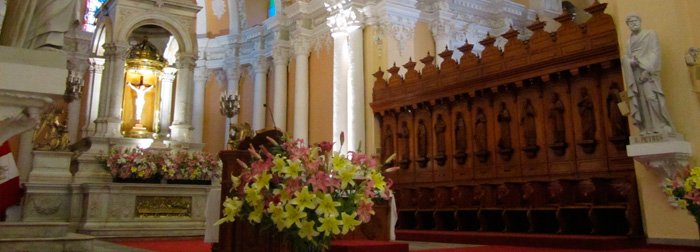
It is the most important neoclassical ediicio Peru, product reconstruction started in 1844 and finished three years later and led by architect Lucas Poblete. Its interior is faced with trs ships with one of the side walls of the main square which fills a side façade is divided by Corinthian columns.
Church of the Company
It is the monument maximum Arequipeña School,[10] is one of the most splendid creations of Peruvian Baroque and starting point of this school, in its façade has an inscription inscribed with the year 1698 which shows that the beginning of the eighteenth century this regional art had reached its peak, therein lies a more exaggerated baroque altar.
Convent of Santa Catalina
Civil-Public Monuments
There are 10 buildings that origin were engaged in civic purposes, such as Phoenix theaters. and the Municipal Theatre, the Goyeneche Hospital and the Hospital of Priests of St. Peter, bridges Bolognesi and Grau, the Instituto de la Rosa Chavez, Railway Station, Mercado San Camilo and the Molino de Santa Catalina.
Military Monuments
The historic center of Arequipa lacked a wall as we had the city of Lima, they persist despite military monuments as Twentieth Century Prison and Penal Fundo El Fierro women.
Civil-Domestic Monuments
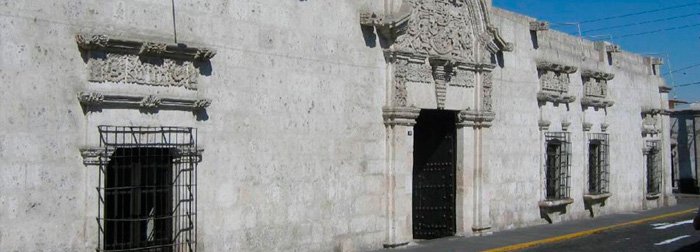
Within the historic center there are 246 houses were declared monuments household, this type of construction is characterized by thick walls made solid as drawer, with arches and domes similar to those built in the temples and monasteries religious, giving the same robustness and monumentality to these constructions built from the seventeenth and eighteenth centuries and generally used for housing.
- Casa del Moral
- Goyeneche Palace
- Tristan del Pozo House
- Mint
- Casona Ugarte
- House Irribery
- House Arrospide
- Casa del Alferez Flowers
- Casona del Corregidor Maldonado
- Casa del Corregidor April and Maldonado
- Casona Goyeneche
- House of Pastor
- Bronze Tambo
- Tambo of the Loggerhead
- Tambo de Ruelas
Parks and gardens
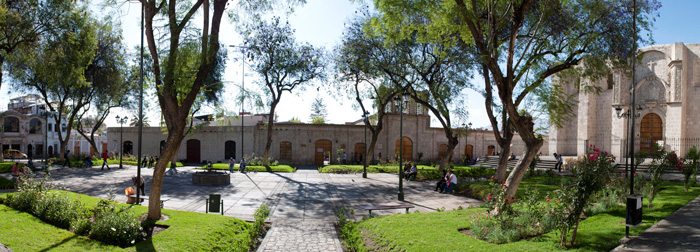
In the historic center of the city’s parks and squares for a total of 26 hectares of green areas that are complemented by 22 acres (9 ha) of countryside within this historic area, between the squares and parks include the following areas:
- Plaza de Armas
- Plaza San Francisco
- Grau Playground
- Biela Park
- Oval Miguel Grau
- Bolognesi Malecón
- Park 28 February
- Parque La Recoleta
- Recoleta park 1
- Recoleta park 2
- Juan Manuel Polar Oval
- Park The Poet
- Benigno Park Ballón Farfán
- Salta Park
- Dante Alighieri Park
- Martinetty Park
- Melgar Park
- South Institute
- San Camilo Plazoleta
- Duhamel Park
- Place 15 August
- Spain Square
- Plaza Santa Teresa
- Plaza Independencia
- Parque San Lazaro
- Park Hotel Libertador
- Selva Alegre Park
- Forest Selva Alegre
- Plaza San Antonio
- Romana Square
- Municipal Nursery
- Selva Alegre Playground
- International Club
Outside this monumental natural areas that stand out are the following:
- Ecological Park of Alto Selva Alegre. is located in the middle of an urban area east of the city, right outside Cayma District and Rio Chili in the territory of the district of Selva Alegre. The park and surrounding areas occupy an area of 1008 hectares of which 460 hectares covering only the ecological park. The back of the park is located in the buffer zone of the National Reserve of Salinas Aguada Blanca.
- Fundo Paradise. is part of the Natural Park of Selva Alegre and occupies an area of 67 hectares.
- Chilina Valley countryside. is part of the Natural Park of Selva Alegre and occupies an area of 151 hectares.
- Chilpinilla Metropolitan Park. 14 hectares.
- Military College Forest Park. 14 hectares.
- Selva Alegre Park. 20 hectares.
Suburbs
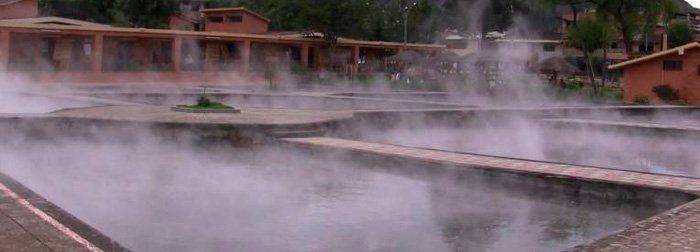
- Yanahuara Villa Hermosa, located 2 kilometres (1 mile) from the city, famous for its churches built in Andalusian style alleys which is Yanahuara Monumental Zone Cultural Heritage of the Nation.
- Cayma Villa, 3 miles (5 kilometres) from the centre of town. Place known for its taverns and where there is a beautiful seventeenth-century church. With a viewpoint which affords a beautiful view of Arequipa.
- The thermal baths of Yura, 30 kilometres (19 miles). Its waters come from inside the volcano Chachani. Also, near the city are the medicinal sources of Jesus and Socosani.
- Sabandía natural valley with most crystalline waters in the region. Here is the Sabandía mill was built and in operation since the eighteenth century.
- The farm Sachaca or the Founder’s Mansion, is 12 kilometres (7 miles) from the city. Built on the river Socabaya, is a residence that belonged to different owners of historic renown in Peru but became especially known for being one of the family properties princiales Goyeneche. This beautiful piece of architecture is now open to the public.

